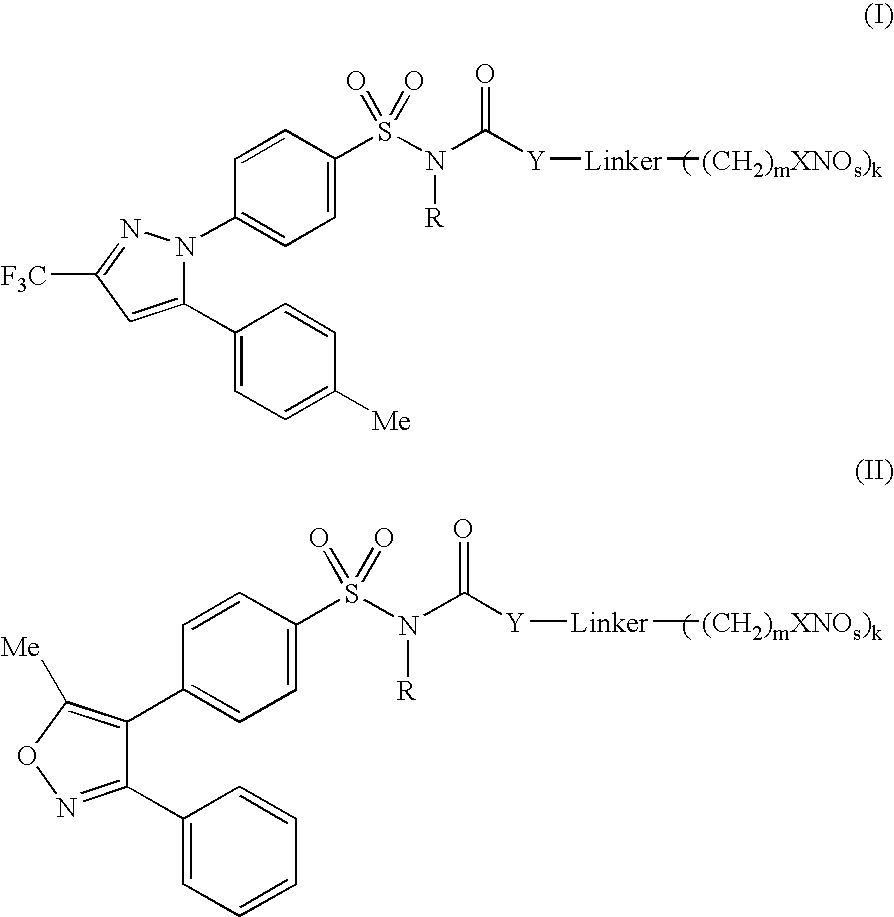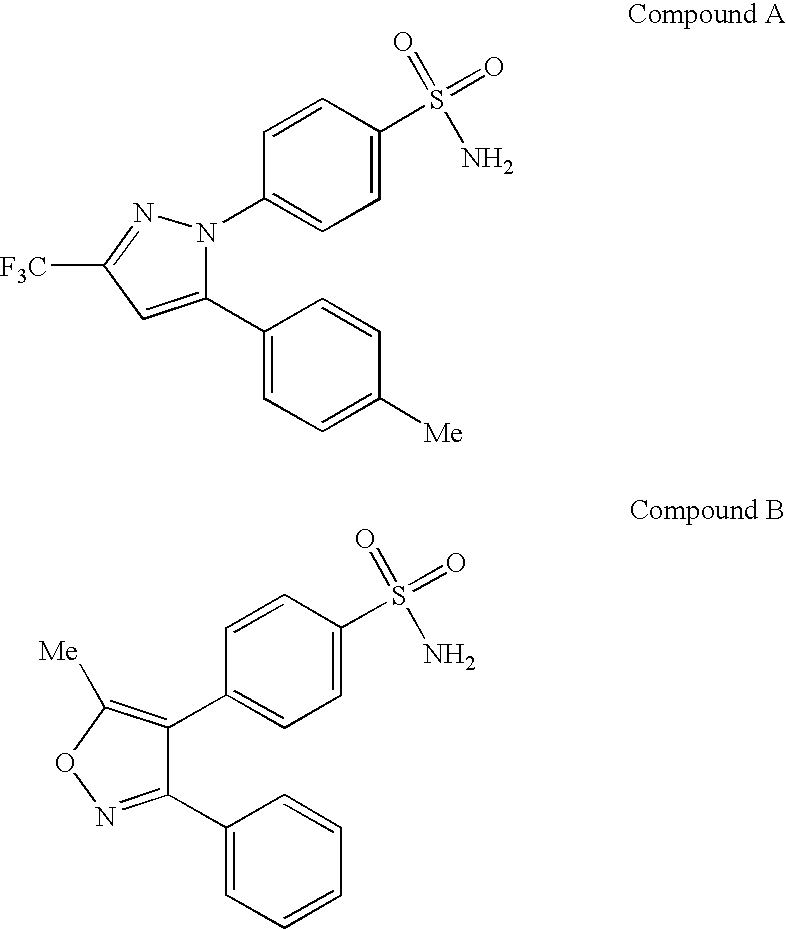Nitric oxide releasing selective cyclooxygenase-2 inhibitors
a selective cyclooxygenase and inhibitor technology, applied in the field of nitric oxide, can solve the problems of limiting the therapeutic potential of nitric oxide, more drastic side effects, and patients with chronic inflammatory conditions, such as rheumatoid arthritis and systemic lupus erythematosis, and achieve the effect of reducing the risk of thrombotic cardiovascular events
- Summary
- Abstract
- Description
- Claims
- Application Information
AI Technical Summary
Benefits of technology
Problems solved by technology
Method used
Image
Examples
example 1
[0209]
4-[(NITROOXY)METHYL]PHENYL {4-[5-(4-METHYLPHENYL)-3-(TRIFLUOROMETHYL)-1H-PYRAZOL-1-YL]PHENYL}SULFONYLCARBAMATE
[0210] To a solution of 3-nitrooxymethylphenol (1.69 g, 10 mmol) and triphosgene (0.92 g, 3.1 mmol) in 100 ml of CH2Cl2, pyridine (0.86 g, 11 mmol) is added dropwise at −78° C. After 1 h of stirring at rt, the final suspension is transferred via a canula to a solution of Celebrex (3.81 g, 10 mmol) and pyridine 0.86 g in CH2Cl2 cooled at −78° C. After 1 h at 0° C., the reaction mixture is poured into a separatory funnel containing EtOAc(50 mL) / NH4Cl(50 mL, sat). The phases are separated and the aqueous phase is extracted twice with EtOAc (2×50 mL). The organic layers are combined, washed with brine, dried over anhydrous Na2SO4 and evaporated to dryness. The crude material can be further purified by flash chromatography eluting with 1:3 EtOAc / hexanes to yield the title compound.
example 2
[0211]
4-[(NITROOXY)METHYL]PHENYL [4-(5-METHYL-3-PHENYLISOXAZOL-4-YL)PHENYL]SULFONYLCARBAMATE
[0212] Starting from valdecoxib, the title compound is prepared by following the same conditions as described in Example 1.
example 3
[0213]
4-{[({4-[5-(4-METHYLPHENYL)-3-(TRIFLUOROMETHYL)-1H-PYRAZOL-1-YL]PHENYL}SULFONYL)AMINO]CARBONYL}BENZYL NITRATE
[0214] To a solution of 4-nitrooxymethylbenzoic acid (1.97 g, 10 mmol) and Celebrex (3.81 g, 10 mmol) in 100 ml of CH2Cl2 is added EDCI (3.8 g, 20 mmol) at 0° C. After 1 h of stirring at rt, the reaction mixture is poured into a separatory funnel containing EtOAc(50 mL) / NH4Cl(50 mL, sat). The phases are separated and the aqueous phase is extracted twice with EtOAc (2×50 mL). The organic layers are combined, washed with brine, dried over anhydrous Na2SO4 and evaporated to dryness. The crude material can be further purified by flash chromatography eluting with 1:3 EtOAc / hexanes to yield the title compound.
PUM
| Property | Measurement | Unit |
|---|---|---|
| body weight | aaaaa | aaaaa |
| length | aaaaa | aaaaa |
| temperature | aaaaa | aaaaa |
Abstract
Description
Claims
Application Information
 Login to View More
Login to View More - R&D
- Intellectual Property
- Life Sciences
- Materials
- Tech Scout
- Unparalleled Data Quality
- Higher Quality Content
- 60% Fewer Hallucinations
Browse by: Latest US Patents, China's latest patents, Technical Efficacy Thesaurus, Application Domain, Technology Topic, Popular Technical Reports.
© 2025 PatSnap. All rights reserved.Legal|Privacy policy|Modern Slavery Act Transparency Statement|Sitemap|About US| Contact US: help@patsnap.com



